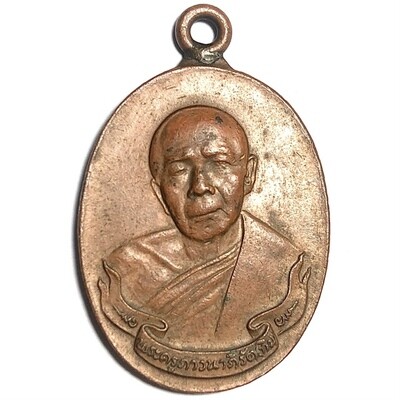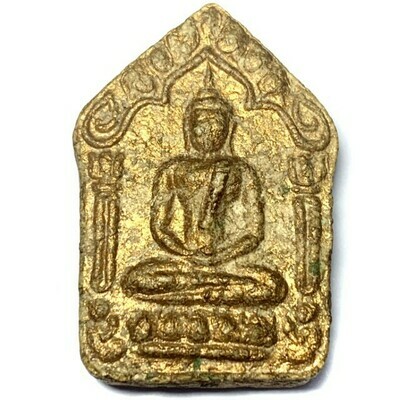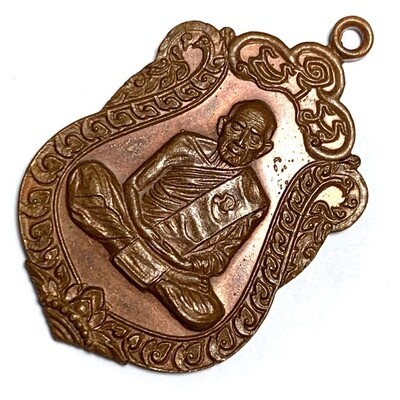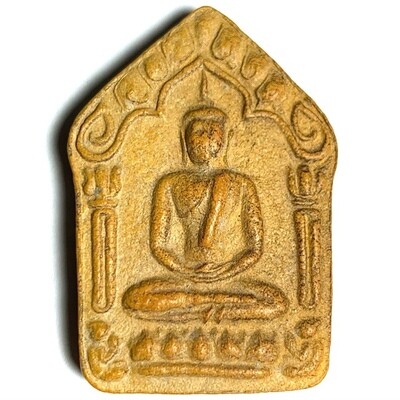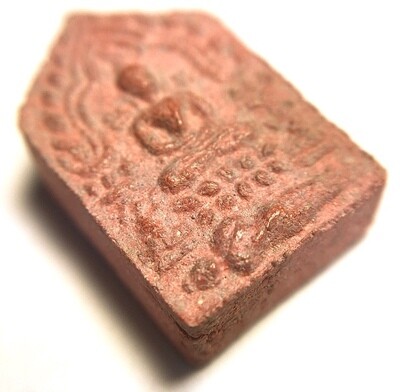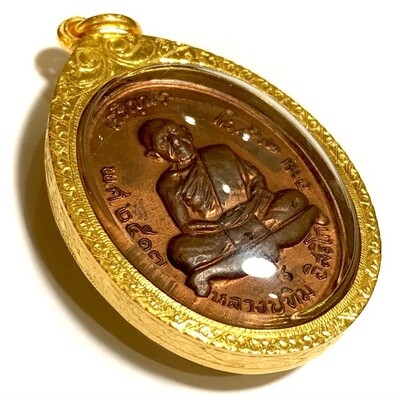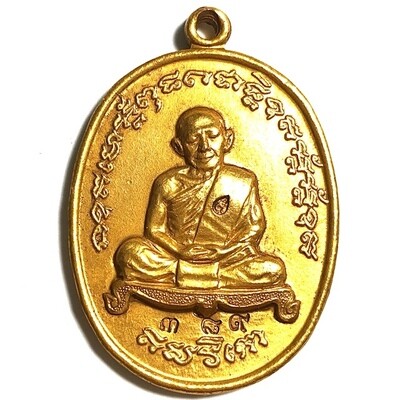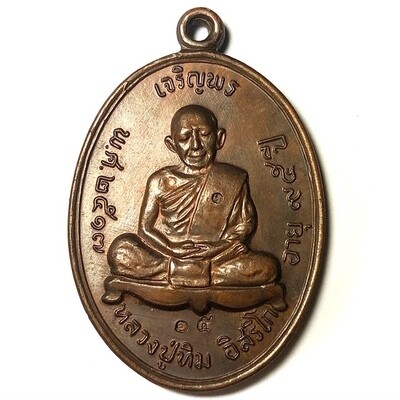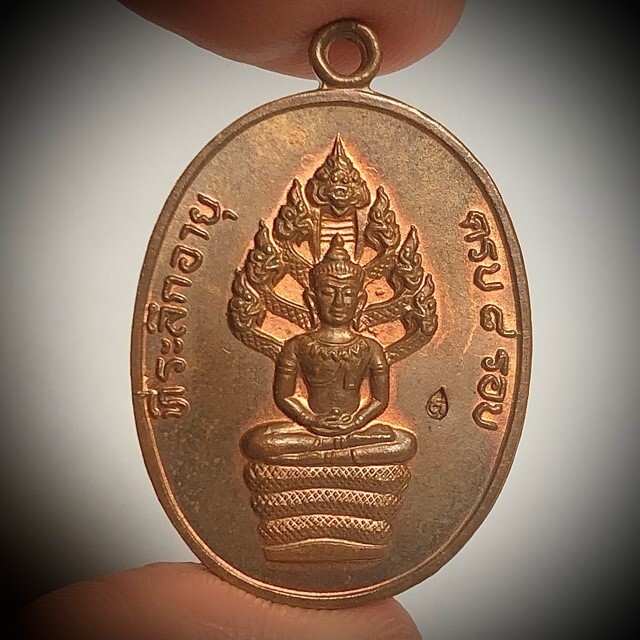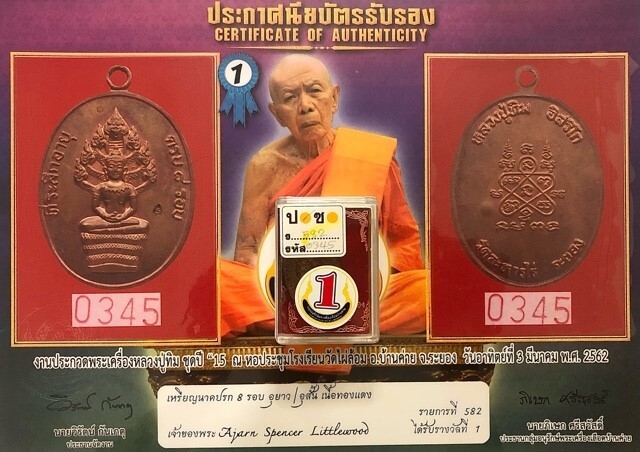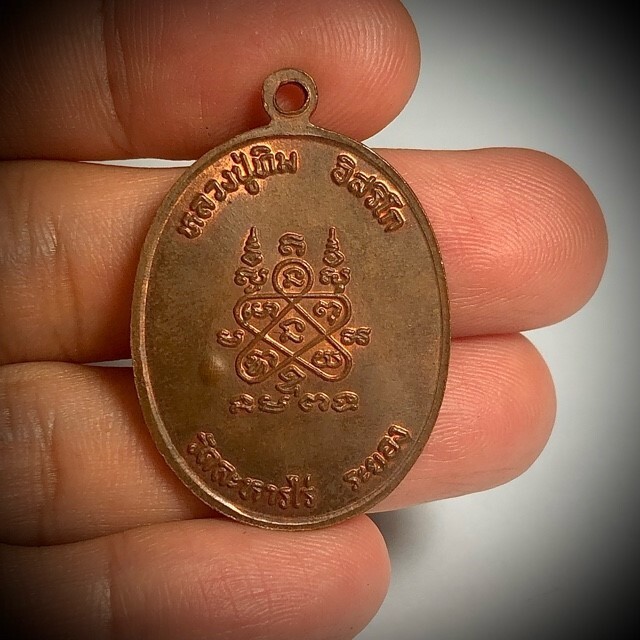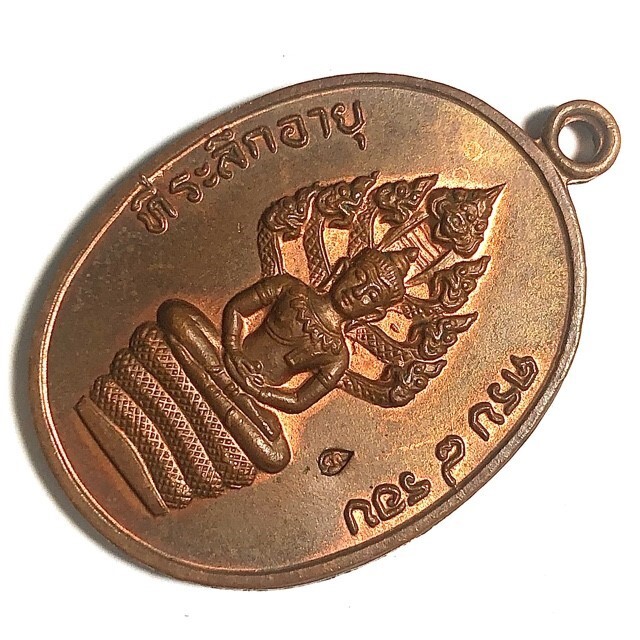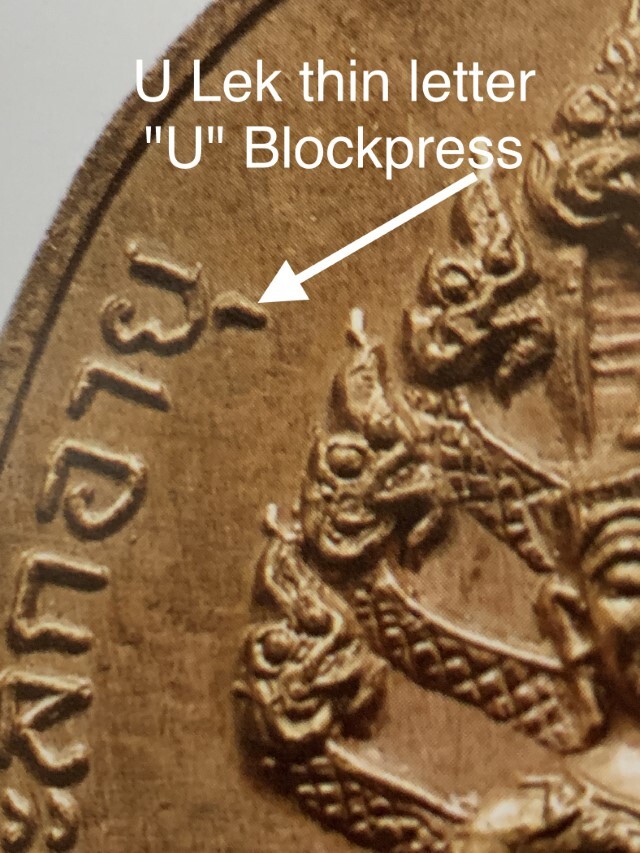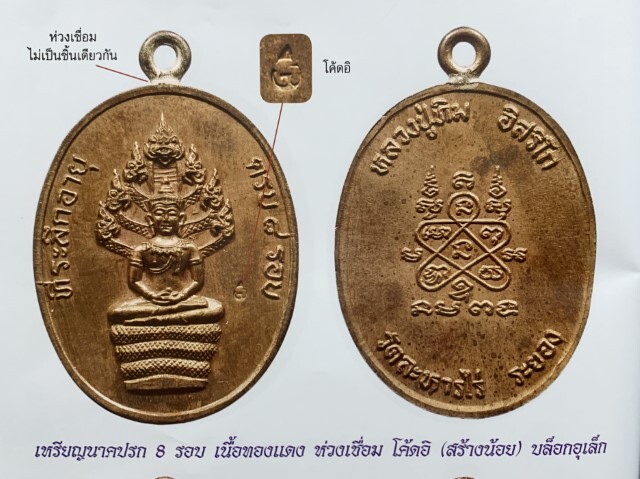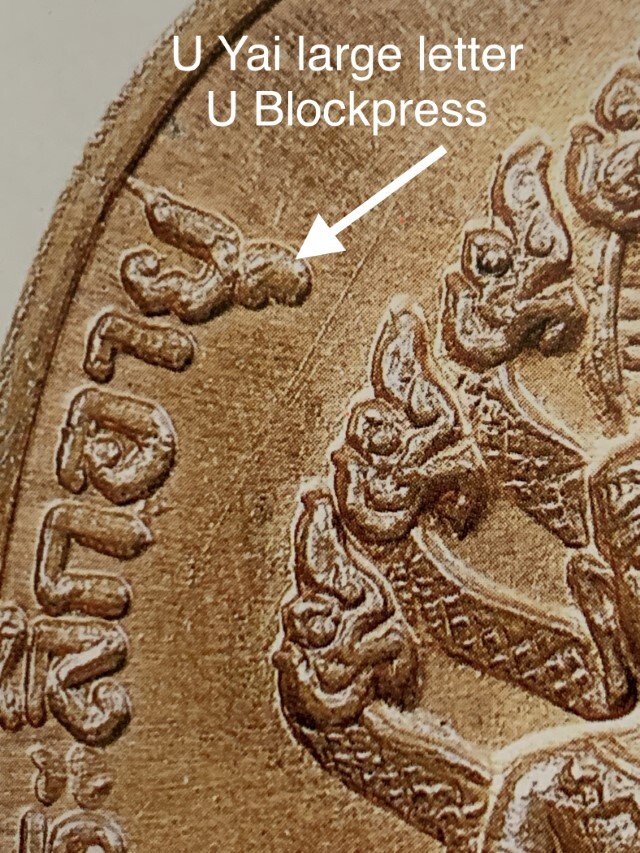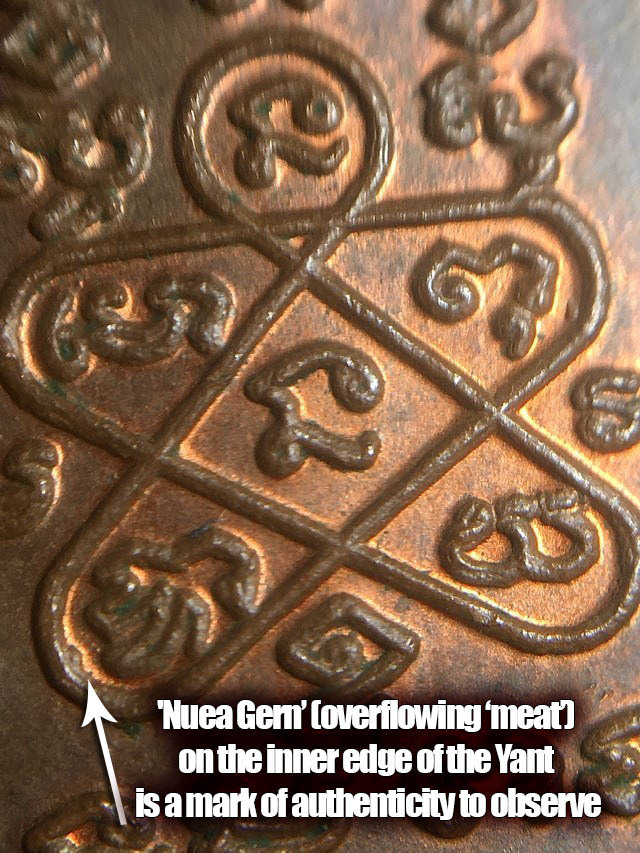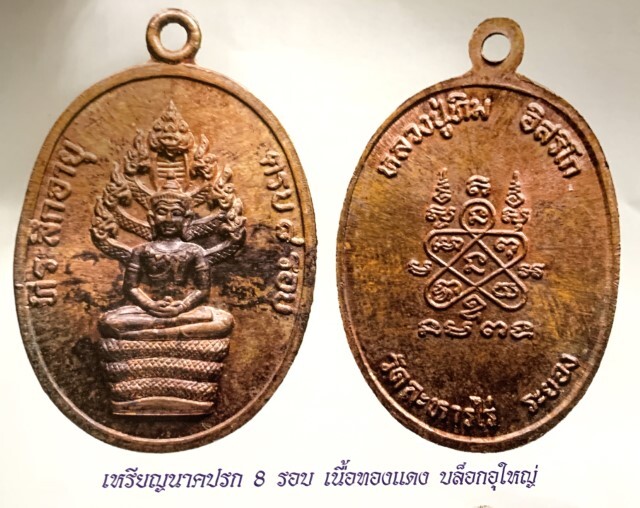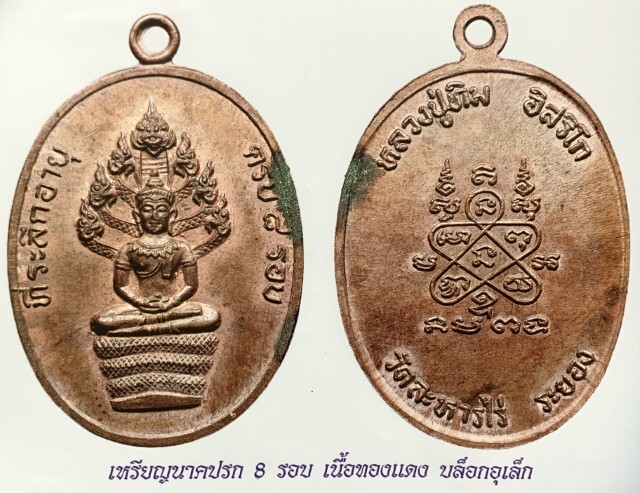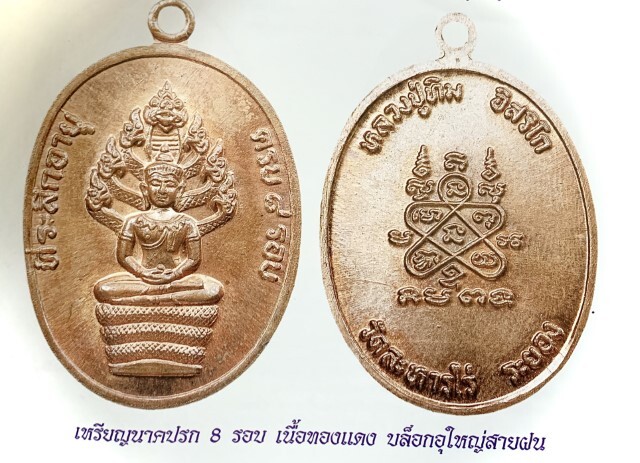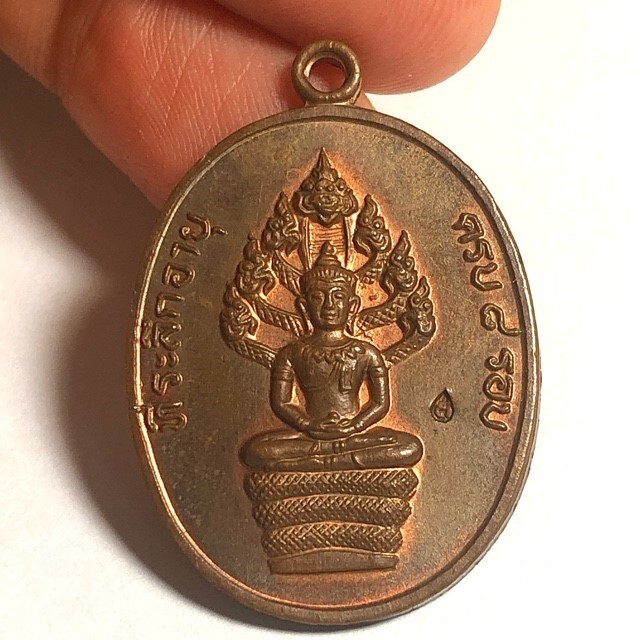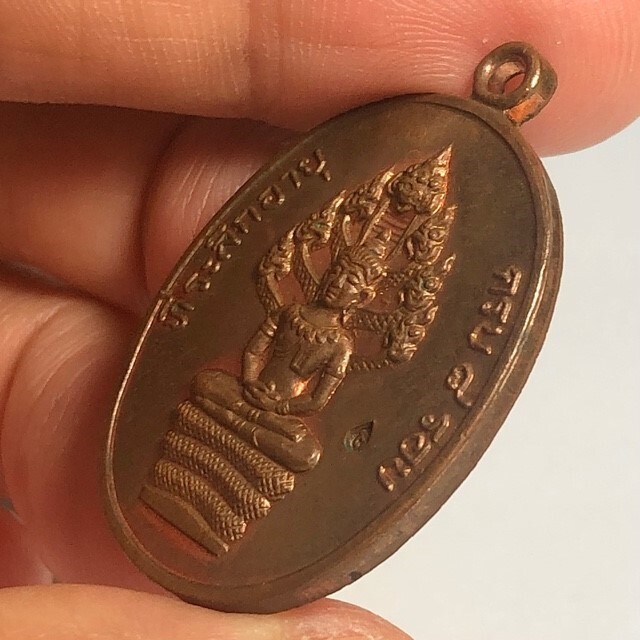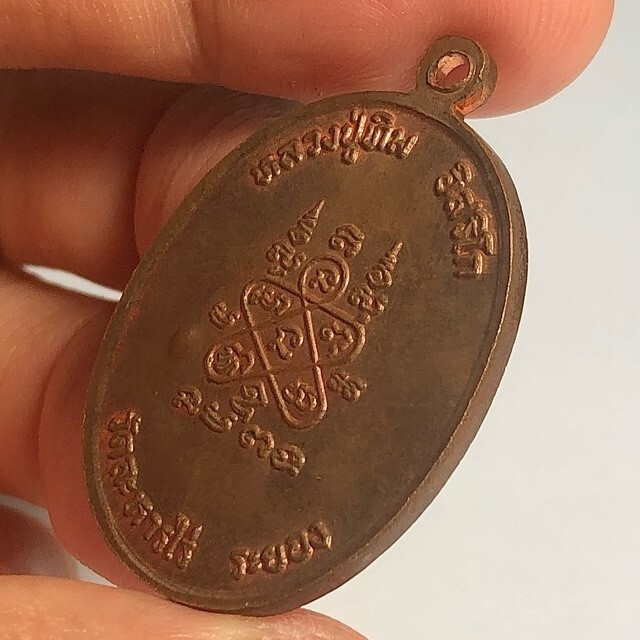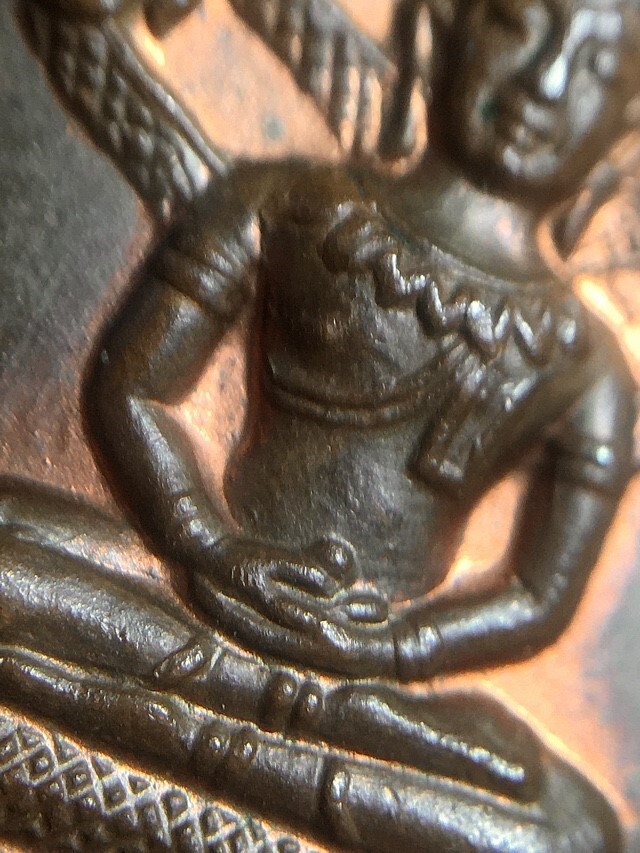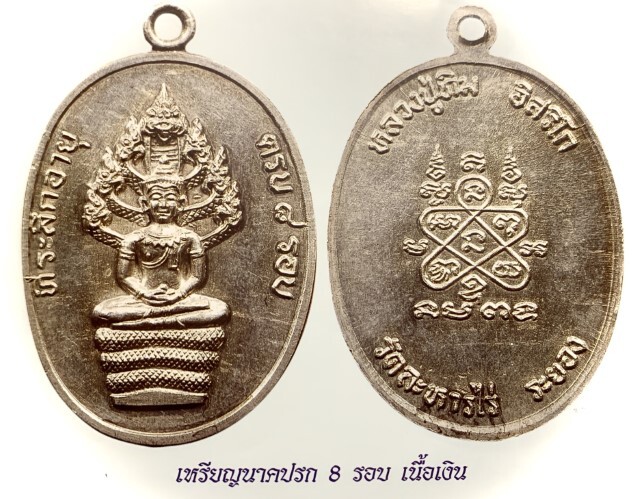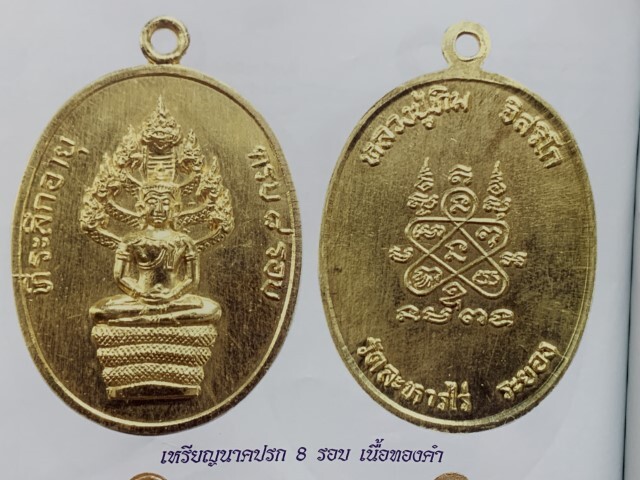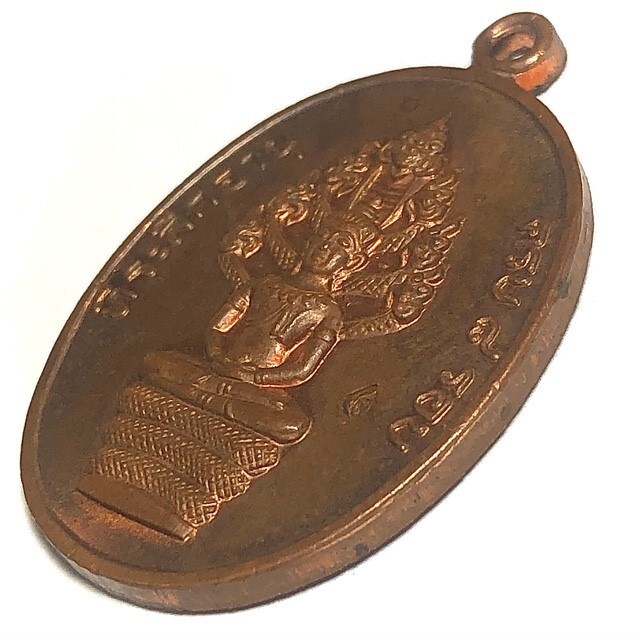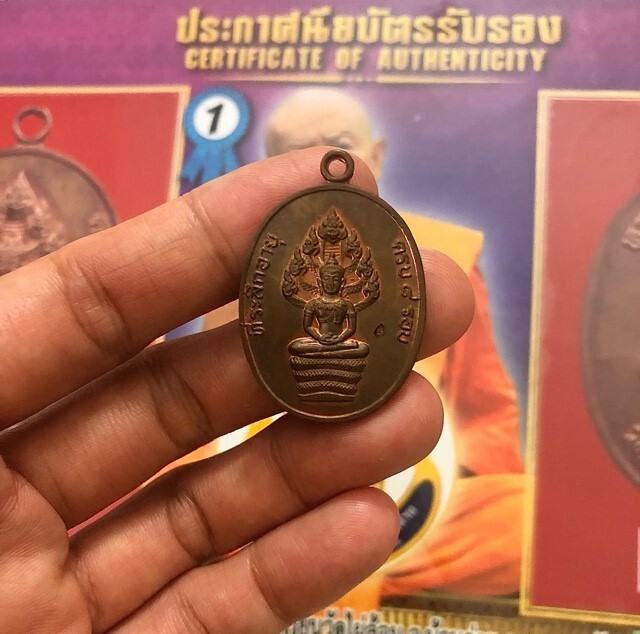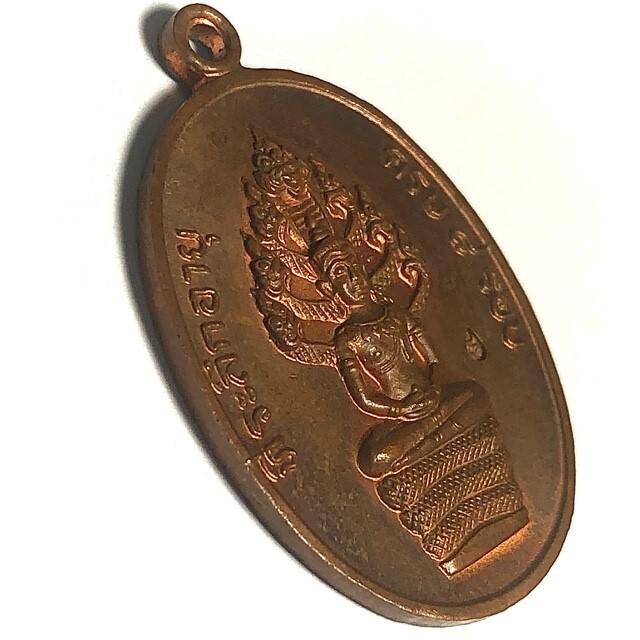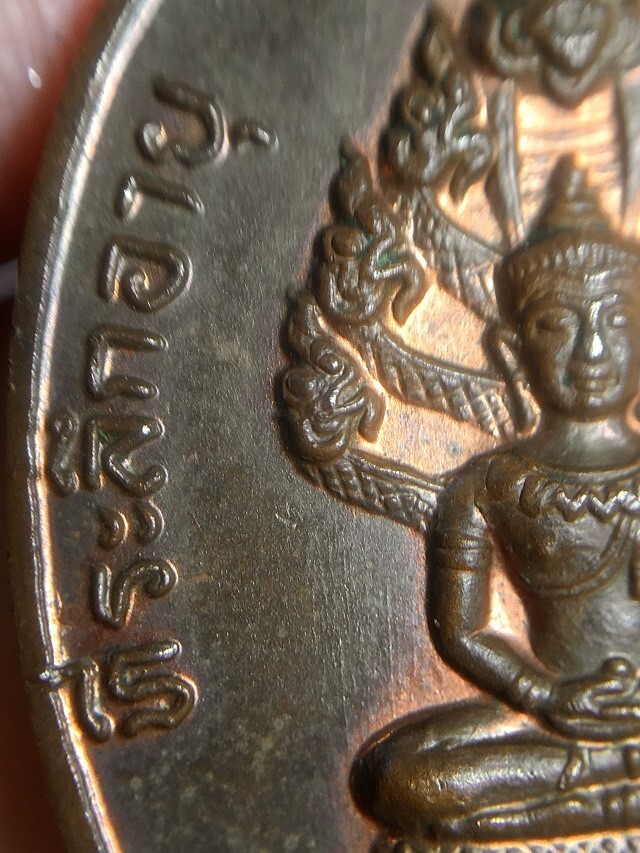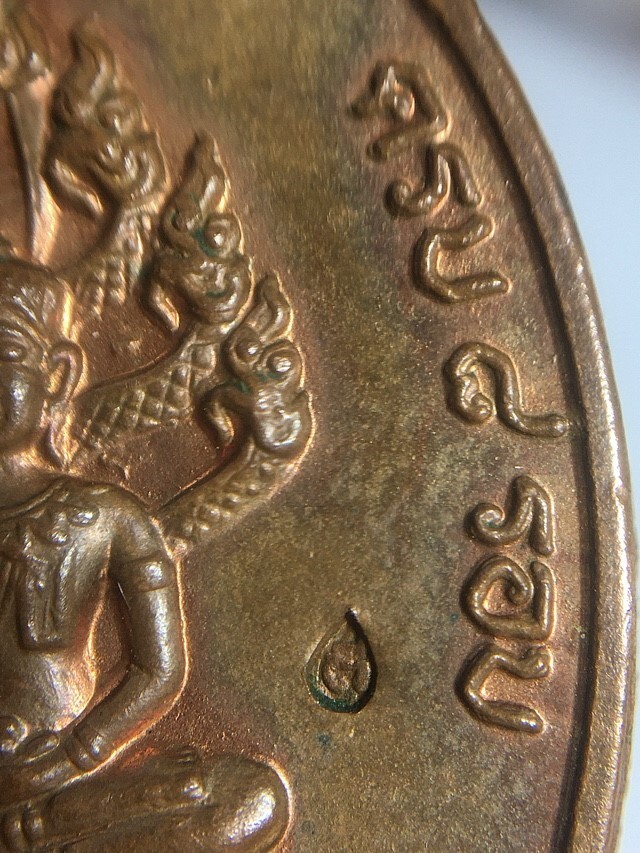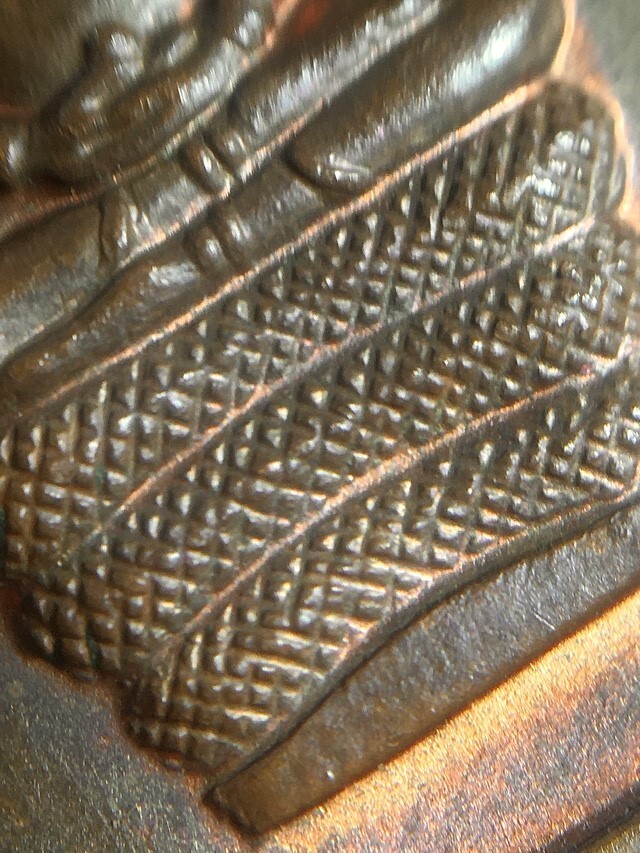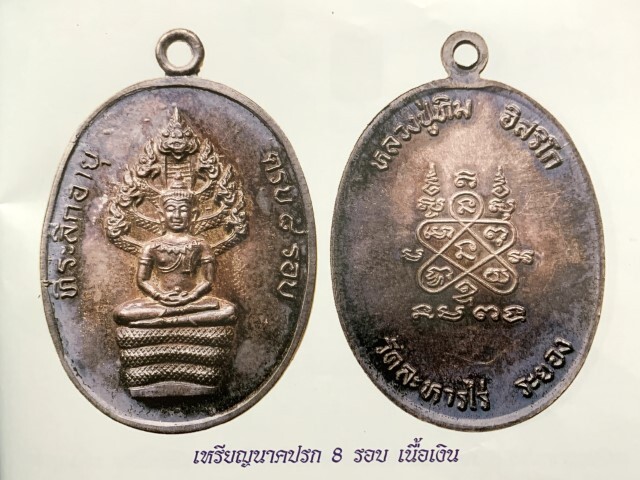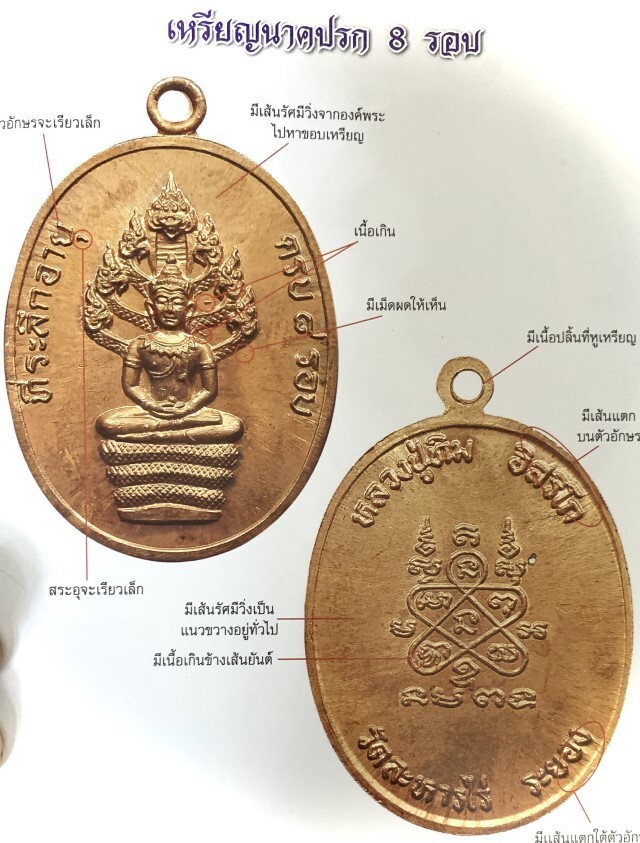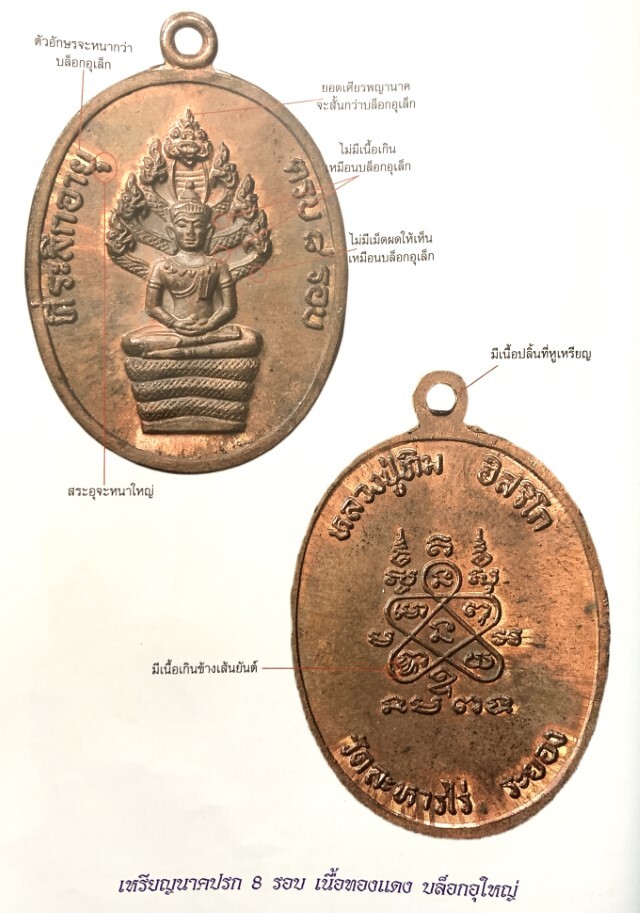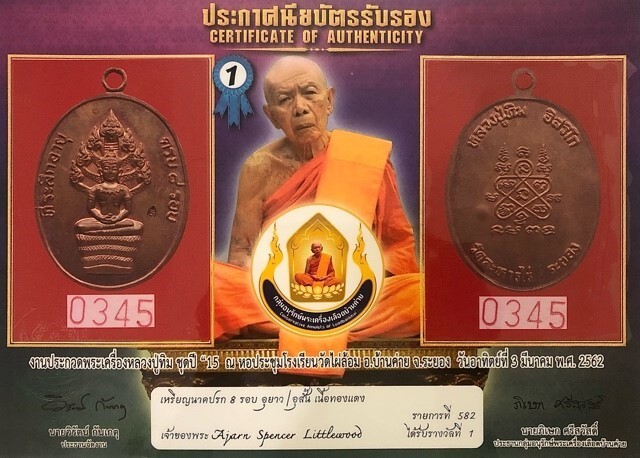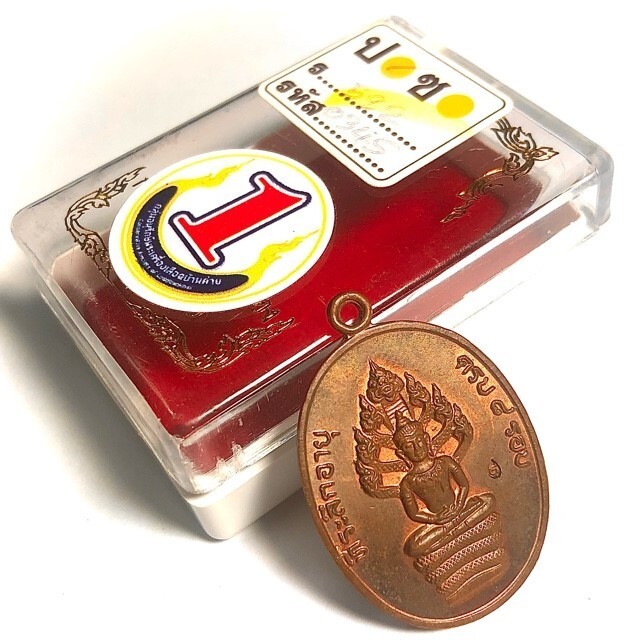Presenting a tiny but powerful and rare classic amulet from one of the Great Khao Or Masters of the 20th Century, Rian Glom Lek Hlang Chedi 2505 BE Nuea Tong Daeng Miniature Guru Monk Coin Por Tan Klai Wajasit
This Sacred amulet of the Great Khao Or Master of Nakorn Sri Tammarat, Master of Wat San Khan and Wat Pratat Noi, is a very rare amulet from Por Tan Klai’s 2505 BE Blessing Ceremony Edition, and is considered a ‘Jaek mae Krua’ type amulet (meaning ‘give to the kitchen maids and temple helpers’), which is suitable not only for men, but due to its miniature size, a perfect amulet for ladies or children to wear.

Rian Glom Lek 2505 BE Por Tan Klai Wajasit Wat Suan Khan
The 2505 BE edition of amulets of Por Tan Klai, is a highly preferred edition, which saw his famous ‘Rian Glom’ round Monk coin amulet with Chakra released, The Rian Glom Lek Hlang Chedi, and the Roop Tai Por Tan Klai Guru Monk Blesséd Photographamulets such as look om chan hmak and ya sen tobacco balls, and sacred powder amulets of various models.
A very rare and highly prized amulet for the devotees of Por Tan Klai to associate with his image and pray to him with a blessed image of the Guru, and the Chedi Relic Stupa on rear face for Buddhanussati and Marananussati. A powerful and Sacred amulet which has passed through the hands of the Guru and been blessed by him.
Por Tan Klai was one of the Top Guru Master Monks of the Last Century, and is considered one of the Four Great Masters of the Previous Generation of Lineage Masters of the Khao Or Southern Sorcery Lineage.
Kata Bucha Por Tan Klai

Rian Nakprok 8 Rorb 2518 Block U Lek Code I 1st Prize Trophy Certificate Nuea Tong Daeng Luang Phu Tim Wat Laharn Rai
One of the rarest of all coin amulets of LP Tim, the Rian Pra Nakprok Paed Rorb 2518 BE, in Nuea Tong Daeng with Khom Agkhara "I" series Code Met Nga (sesame seed shape stamp), from the great Luang Phu Tim Issarigo, of Wat Laharn Rai. A First Prize Trophy Winner competition-class Certificated authentic amulet, with A4 size Certificate, and Complimentary Trophy, from the Samakom Anuraks Pra Krueang Luang Phu Tim Luead Ban Kaay of Rayong, where the amulet was Certificated and Signed as Authentic by the president of the association, Dr. Ajarn Phisek Sri Sawad.
The Rian Nakprok was released in both the Paed Rorb, and the Traimas 2518 Ceremonies. We are very proud to present this pristine, extremely rare "Block U Lek Code I" Block Press amulet of Luang Phu Tim's eternal classic Guru Monk Coin; The 2518 BE, Rian Pra Nakprok Buddha on Naga Throne coin, in the extremely rare with Khom Sanskrit letter "I", in Nuea Tong Daeng, emobossed on the front face inside the 'Met Nga' sesame shape (the common lay-folk have come to call this the 'sesame seed stamp', but in truth, it was surely intended to represent a lotus petal).
Above and Below; the Amulet comes with First Prize Winner Trophy and A4 size Certificate from 3rd March 2562 BE Competition at Wat Pai Lom Temple next to Wat Laharn Rai.
The front face features an image of the Buddha seated upon a Naga Throne, with 7 Headed Naga Canopy, depicting the moment when the Naga King of Bodhala raised his head over the Buddha to shelter him from the rain in his meditation. To the side of the Buddha to our right, there is the a Met Nga stamp with Sacred Khom Letter "I" (for 'Issarigo), embossed.
The left side of front face has the words 'Tee Raleuk Aayu' (to commemorate age), and letter "U" in the word 'Aayu' has the thinner typescript of the rare Block U Lek Code I amulet, which can be found with both forged pendant hoop, and soldered. Only very few amulets were pressed in this version. This is of course a highly influential reason as to how and why this particular amulet won first prize trophy in competition.
Below, an example of one of the Block U Lek Code I amulets in the Dton Rak Pra Catalog of the Pantheon of Amulets of LP Tim.
Below, an example of one of the Block U Yai amulets in the Dton Rak Pra Catalog of the Pantheon.
The rear face on all models used the same block press, to emboss the Sacred Yant Grabong Khwai of LP Tim. One of the authentication reference points for easy checking, is the 'Nuea Gern' extra blob of metal on the bottom left corner of the Yant Grabong Khwai, on the inner edge of the lettering.
The Rian Nakprok was also released again the same year in the Traimas edition, using the same cut blank coin press as the Rian Paed Rorb, but, imprinting the font faces with two new designs; the Block U Yaw, and the Block U San (long and short tailed "U" vowel on the front face edge lettering). The Rian Nakprok Traimas, also used a different rear face block press and Sacred Yant to the 'Paed Rorb' edition. The Traimas edition.
Below; Some of the Other Block Presses in the Paed Rorb Edition;
RIAN NAKPROK PAED RORB NUEA TONG DAENG BLOCK U YAI
RIAN NAKPROK PAED RORB NUEA TONG DAENG BLOCK U LEK
RIAN NAKPROK PAED RORB NUEA TONG DAENG BLOCK U YAI SAI FON
This particular block press, was one of various block press models released in the Paed Rorb edition, which included Solid Gold (7 coins made), Silver (397 made), and Nuea Tong Daeng Sacred Copper (20,000 made). The 3 major block presses included were the Block U Yai, Block U Lek, and the block Yai Sai Fon. But the rarest of all, is the original mother block press, the Block Dton Baeb, of which only very few were made, after which the other block press front faces were pressed using the other 3 block-press molds.
The famous experts of the last few decades, and book publishers, always state that there were only 3 block presses, but they all then show pictures of four, stating the Block Dton Baeb as the Original Block Press! This is an inaccuracy born of not being observant or thoughtful enough to realize, that if the Mother Block Press is the original, and there are three others, this makes 4 Block Presses, not 3!
RIAN NAKPROK PAED RORB NUEA TONG DAENG BLOCK DTON BAEB
Also, any of you who read Thai documentations and websites, will have noticed, for some strange reason, in the 'land of samadhi meditation' most authored works are sloppily composed, & full of discrepancies, such as 'He was born in 2524, he was ordained in 2444'. Which would mean he ordained 100 years before he was born! Many Monk Biographies in Thai, I find myself having to do research to confirm and to iron out the silly nonsense to be found on the Thai Web and even in Books and Magazines, which is often a mishmash of copy and pastes from differing accounts that conflict with each other, that do not make sense, and try to turn it into factual info, that makes logical sense.
I find Thai language authored works often to be undiligent, written without accuracy and focus, which is why I am constantly finding documentations where people died before they were born, ordained a hundred years after they died, and so on. I rely more on information I retrieve from the local devotees and aged Looksit of the temples, who are much more likely to know all the stories that Bangkokian Showroom owners and societies do not. How could they? If they never spent time studying with the local elder devotees, and the monks themselves, staying in their showrooms, talking sales talk all day?
I must however add, that I myself have sometimes mistyped dates through lack of concentration, and not seen that I hit the number 4 on the keyboard, instead of the 5 key for example, which also leads to confusion (typo errors). The level of intricate details involved when researching and documenting dates, block presses, and reference points, is very complex, and it is very easy to lose concentration if interrupted during one's work. Hence, one cannot blame anyone truly for slight discrepancies in their attempts to publish increased knowledge, in their journey of study, which is a lifetime journey, where you never stop learning.
This, is yet another reason why I the author (Ajarn Spencer), prefer to use books only to gather as much basic knowledge as is found in them, but never to assume, that there is where the information ends, and never accept what does not make sense, until I can find a reasonable explanation as to the confusing data given in most academic publications on authentic Thai Amulets. Most of them are informative, but, like most info books, incomplete.
These catalogs are hence for me, not the alpha and omega, the be and end all of Info. They are merely a starting point of study, but i have found that when i use common sense and logic, and study deeply, visit the temples and ask to study their archives, and such things, then you can find out much more accurate data than just sticking to believing what you read in a magazine! In the end, it is my own efforts and diligent eyes, that enable me to authenticate, not magazines, or the statements of others who have attained recognized status as Elder Pundits of the topic. I view them as a good foundation and basic starting point to branch out from, but one must still search deeper for further knowledge, once your insights increase.
RIAN NAKPROK PAED RORB NUEA NGERN
The Pra Nakprok is also known in Thailand as Saturday Buddha, and is the 'Birthday Buddha' for those born on Saturdays, also, Saturday, is the day for Worshipping Pra Nakprok. The Image is of the Buddha sitting in Samamadhi (concentrative meditation), on top of a Naga, the Naga’s head is raised over Buddha’s to form a canopy. It is known as “Paang Nakprok” The Buddha remained in blissful rapture under the Acabhalanikaroda for seven days, whereupon he moved to the Mucalinda tree to the Southeast side of the Bodhi tree. A terrible rainstorm began, pouring down on the forest for a whole seven days without stopping. Payanaga Mucalinda, who was King of the Nagas, came up from the naga Realm in the underworld and coiled himself underneath the Buddha, making a cushion seven stories high, to keep him dry.
He rose up and leaned his head over the Lord opening his neck canopy to shade the Buddha from the rain, as well as keeping watch to protect him from all sorts of parasitic, poisonous and preying animals and creatures. As the rains ceased to fall, the Naga King uncoiled and changed into a Human form and raised his hands in reverence to Buddha. In this moment, the Buddha uttered the following Kata (words);
Sukhoewiwego Dtudtassa Sudtadhammassa Bpassadtoe Abhayaabpach-chang Sukhang Loke Bpaanapuudtesuu Sanyamosukhaa Wiraakadtaa Loke Gaamaanang Smadtiggamo Asmimaanassa Winayo Edtang We Bparamang Sukhang
“Tranquility is the pleasure of he who has listened to and understood the Dharma intently, who sees conditioned things for what they really are, and does not seek to harm others. Of he who has abolished his passions and cravings, lust and desires, he who has stepped beyond all craving for sensual pleasures and endured in his efforts to do away with self conceited attitudes, has the greatest pleasure”.
The statue of Buddha sitting on seven coils of the Naga King snake, was first created, to remember this occasion of the Naga paying reverence to Lord Buddha, and the representation of him sitting on top of the coils as if seated upon a royal throne is used for two reasons; 1. Aesthetics, 2. Brahmin influence. A more authentic and historical version of this Buddha image, is sometimes seen in the form of the Naga's coils wrapped around and covering the Buddha’s body, with four or five coils around him. The only part of the body visible being Lord Buddha’s shoulders, neck and head, which is also semi enclosed by the head and canopy of the Naga leaning over him.
Kata for Pra Nakprok
Yadtohang Pakiniariyaaya Chaadtiyaa Chaadto Naapichaanami Sanjijja Bpaanang Chiiwidtaa Wo Ro Bpedtaa Dtena sajjena So Dti Dte Ho Dtu Kappassa
Free Express Shipping is offered Worldwide Included in the Price for this Amulet, and the offer of free solid silver, stainless steel, or waterproof casing if desired. The amulet comes with complimentary box, and A4 size Certificate of Authenticity included. The Rian Nakprok is very famous for its Metta Maha Niyom Mercy Charm, to attract and seduce customers and admirers, attract wealth, and improve Karma, as well as for the many stories of miraculous lifesaving events retold by devotees who have worn and revered this amulet. The 1st Prize Trophy, and A4 size certificate of authenticity will be plasticized and sent with the amulet to you.
This rare Pim Niyom coin amulet of Luang Phu Tim, is a wonderful opportunity for devotees who seek the true power of a world class amulet from a world class edition, and also a wonderful Ongk Kroo reference study exhibit to peruse under the eye loupe.
The amulet is a perfect and authentic study material, to train the eyes as to the appearance of the Classic Coin amulets of Luang Phu Tim Hence, the amulet is also a perfect 'Ongk Kroo' reference study material for students of the Pantheon, and will increase your chances of spotting an essential rarity at the right price, and without danger of risking a fakery.
Various variations were made using different sacred metals, and differing code stamps and block presses, which makes for a complex documentation, which left the Samakom Pra denying some now universally accepted models, due to the difficulty in documentation. As the decades have passed and various investigative authors have gathered and compiled a more complete encyclopedic work of the pantheon, it is much easier to define and pinpoint which series and block press each amulet comes from. Although, there is yet much to be discovered and told about the full history of LP Tim and is amulets, for his early and mid era was hardly documented, as LP Tim avoided attention, and most information was word of mouth to ear.
Once every so often, new information arises, and the knowledge of his amulets traces further back in time, beyond what the 'Pundits' ever recounted, or perhaps imagined. It is impossible that a Nationally famous monk would only make amulets in the last 3 years of his life after decades of being a highly revered monk, famous for Wicha Pong Prai Kumarn, and the Wicha Khun Phaen, Yant Pad Boke, and Look Om. It is hence obvious, that Luang Phu will have been making amulets at least since age 50, and considerting he pased away at age 85, this means 35 years before 2518 BE, which indicates, that a lot more yet to be documented early era amulets of Luang Phu Tim are out there, waiting to be discovered.
RIAN NAKPROK PAED RORB NUEA NGERN
Below; Video of another famous Guru Monk Coin model of the pantheon of LP Tim; A second prizewinning exhibit of the Rian Jaroen Porn Pim Jor Gradok Block Press, for enjoyment, and intimate study.
Below; Encyclopaedic Documentation of the Rian Pra Nakprok in the Dton Rak Pra Editorial
Luang Phu Tim Issarigo, is of course not only one of the most highly acclaimed and sought after Guru Monks for his amulets, he is the holder of the highest esteem in Thai Buddhist amulet history for Pong Prai Kumarn powders, highly reputed for powerful Metta. Maha Lap Maha Sanaeh Power.
Luang Phu Tim, is Internationally Acclaimed, for his famous Pra Pong Prai Kumarn amulets, and Look Om powder balls. As to the classic 'Rian' type coin image amulets which have become all time favourites, and eternally, world famous classic amulets of the high end variety. His Rian Jaroen Porn, (both Jaroen Porn Bon and Jaroen Porn Lang versions, in Niyom and Pim Jor Gradok), his Rian Huang Chueam, Rian Traimas, Rian Sema, Rian Pra Jao Thaksin, and Rian Nakprok are among the most highly sought after coin amulets of all. This amulet is hence not only one of the world's most desired and hard to find amulets of LP Tim, renowned for its sacred power, making this an extremely desirable acquisition for any true devotee of Luang Phu, or collector of the amulets of Luang Phu Tim. An amulet with a past, a present, and an eternal future of fame and legend, with decades of confirmed miraculous power coming from the devotees who pray to and wear this amulet.
Kata Bucha Luang Phu Tim Issarigo
(chant to the Triple Gem first (Namo Tassa) 3 times)
Idti Sukadto Arahang Putto Namo Puttaaya -- Ma A U Tugkhang Anijjang Anadtaa Putto Putto
